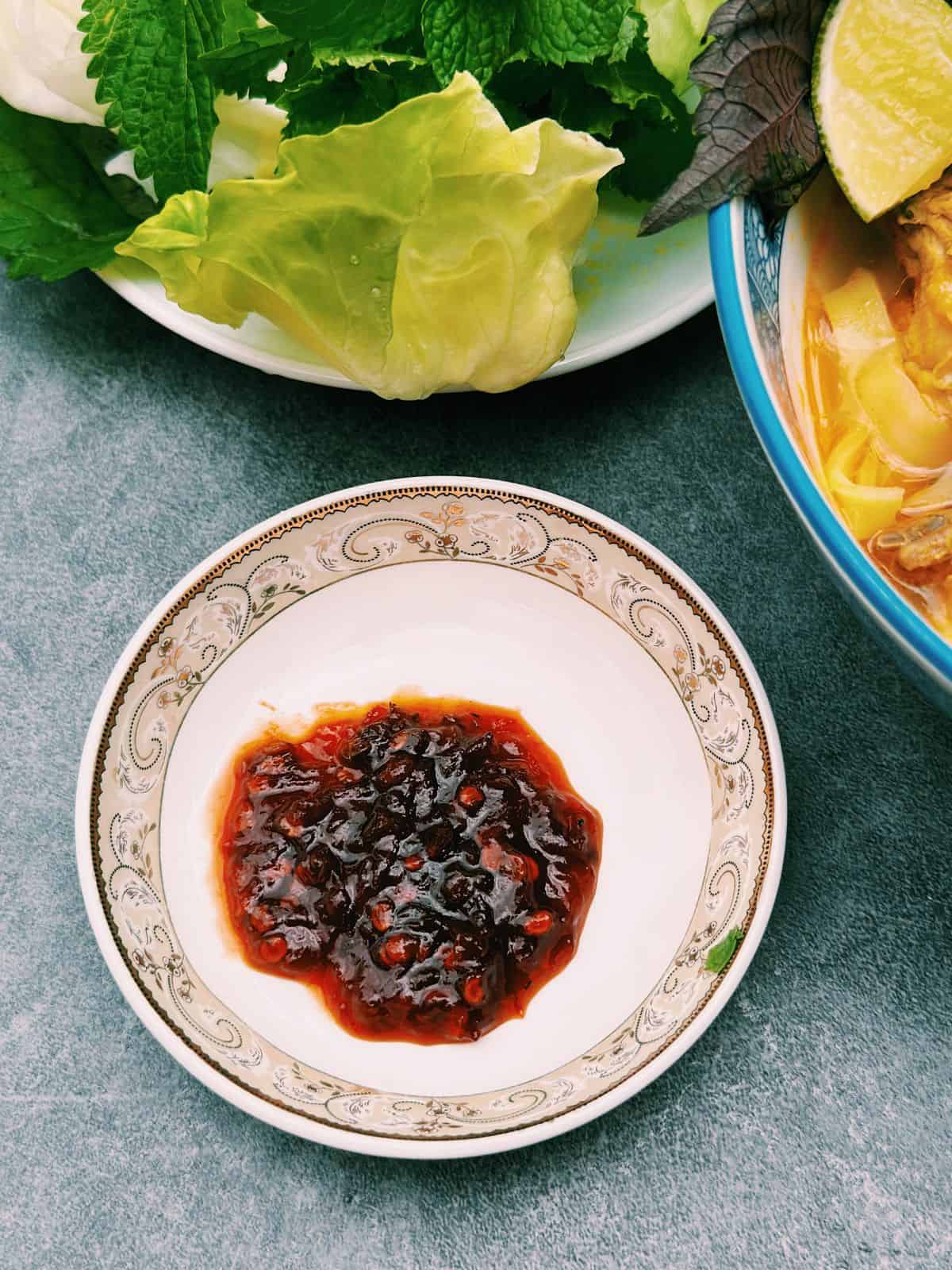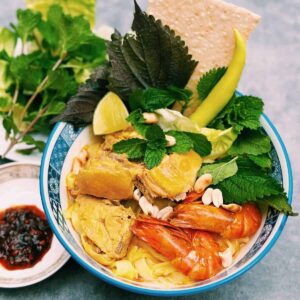Mì Quảng is a Hội An classic! Back home this time, I made it for my parents—my dad loved it so much he begged for seconds.
Here’s my version, with local flavors and easy swaps if you’re cooking it abroad.

What’s Inside
What is Mì Quảng?
Mì Quảng is a must-try noodle from Central Vietnam, especially in Đà Nẵng and Quảng Nam, where Hội An’s old town sits. Fun fact: in 2025, the two provinces officially merged again.
Despite “mì” usually meaning wheat noodles, Mì Quảng is made from rice.
And while many dishes like Pho or Bun Cha can drop the city name, Mi Quang and Bun Bo Hue carry their region in the name—it’s part of what makes them special.

Vietnamese rice noodles usually come in two styles: a full soup, like Bun Rieu, Bun Moc or salad-style with Vietnamese fish sauce, like Bun Thit Nuong, Bun Bo Xao, Bun Cha Gio.
But Mì Quảng? It sits in between—just a splash of broth that hugs the noodles.
If you’re in Hội An, don’t stop at Mì Quảng—Cao Lầu with smoky five-spice pork and the local Hoi An chicken & rice are absolute musts too.
What makes Mì Quảng truly authentic?
In Vietnam, for Mì Quảng, two ingredients are non-negotiable:
Củ nén – it has this wild, earthy scent that sits somewhere between shallots and garlic. No củ nén? White pearl onions come close. Regular onions work if there are no choices.
Extra-virgin peanut oil (dầu phộng) – when it meets the củ nén, the fragrance is next-level. Regular cooking oil will do in a pinch, though it won’t be quite the same.

Ingredients
- Mì Quảng Noodles: These are wide, flat rice noodles—chewier and a bit thicker than Northern Phở. In Vietnam, they’re usually white or turmeric-yellow. Flat rice noodles for Pad See Ew work, and Ho Fun/Chow Fun noodles are a decent backup—they’re silkier and more delicate, but still tasty.
- Chicken: Traditionally, a whole chicken is used—the bones give that deep, umami-rich broth. At home, drumsticks or thighs work best. Avoid chicken breast—it dries out too easily.
- Shrimp: Shell-on shrimp with thin shells hold up best, but peeled shrimp are fine too.
- Quail eggs: Classic addition, though I forgot this time!
- Herbs: Mint and lemon basil (lá é trắng) are traditional. You can mix in perilla, Thai basil, or other Vietnamese herbs.
- Aromatics: Củ nén (or pearl onions), shallots, and garlic form the flavor base. No củ nén? Regular onions work.
- Coloring: Fresh turmeric gives that golden hue; turmeric powder works too. Annatto oil is great, or a paprika-oil mix. Heads-up: both turmeric and annatto stain easily.
- Vegetables: Baby mustard greens, bean sprouts, shredded banana blossom. If unavailable, cabbage or salad greens work. In Germany, arugula is surprisingly good—adds a peppery kick.
- Crunchy toppings: Roasted peanuts and sesame crackers—essential for texture.
- Seasonings: Fish sauce, chicken powder, and a bit of sugar make the broth rich and bold. Mì Quảng broth is saltier and heartier than other Vietnamese noodle soups.
- Optional heat: A spoonful of Hội An chili sauce or Sa Te adds the perfect kick. Local green chilies on the side? Jalapeños work too.



Instructions
Step 1: Marinate the Chicken & Shrimps
- Finely chop or crush garlic, pearl onions, shallots, and turmeric together.
- In a bowl, combine chicken with fish sauce, chicken powder, sugar, 1/3 of the aromatics, and annatto oil. Mix well and let it marinate for 30 minutes.
- Peel and devein shrimps (skip if small with soft shells). Mix shrimps with fish sauce, sugar, annatto oil, and 1/3 of the aromatics. Let them marinate for 30 minutes.
Step 2: Cook the Chicken & Shrimps
- Heat peanut oil in a sauté pan and stir-fry the remaining aromatics until fragrant. Add the chicken with its marinade. and boiled quail eggs.
- Adjust seasoning with more fish sauce. Stir-fry over medium-high heat until flavors are absorbed. Pour in water and simmer on medium-low for ~30 minutes. Broth should be saltier than usual.
- In a separate pan, heat peanut oil and cook the shrimps over medium-low heat with the lid on. Stir occasionally until most liquid evaporates, leaving a flavorful sauce.
Step 3: Assemble the Bowl
- Cook flat rice noodles according to package instructions. Rinse and drain well.
- Place noodles in a bowl. Layer with vegetables and herbs, then add chicken and shrimps. Then, pour in the chicken broth.
- Enjoy with roasted peanuts, cracked sesame crackers, and optional lime juice.
- For spice, add Hoi An chili sauce or green chilies.

Expert Tips
Broth consistency: Mì Quảng isn’t a soup—you want just enough liquid to coat the noodles.
Marinate for depth: Even 20–30 minutes makes a difference. The longer, the more the chicken and shrimp soak up the flavors.
Use chicken broth: Swap water for chicken broth to boost flavor and cut down cooking time.
Prep ahead: You can cook the chicken and shrimp a few hours before serving, but wait to assemble the noodles and pour the broth so everything stays fresh and flavorful.
Get creative with protein: Bone-in chicken is classic, but pork ribs make a delicious Mì Quảng Sườn. In Vietnam, you’ll even find versions with frog or jellyfish for something adventurous!
FAQs
More true-to-Vietnam flavors
Instant Pot Chicken Pho (Hanoi Style)
Vietnamese Spring Rolls with Hoisin Peanut Sauce (Gỏi Cuốn)
Vietnamese Crispy Pancake (Bánh Xèo)
Banh Mì Sandwich with Cha Lua and Do Chua (pickled carrots & daikon)
Vietnamese Steak & Eggs (Bò Né)
Fried Spring Rolls (Nem Rán, Hanoi-style)

Mì Quảng – Authentic Central Vietnam’s Turmeric Noodles
Ingredients
Chicken Marinade & Broth
- 1.5 pound chicken thighs (700g) (see note 1)
- 1 tbsp chicken powder
- 2 tbsp fish sauce
- 1 tbsp sugar
- 8 boiled quail eggs (optional)
- 2 tbsp annatto oil (or 2 tbsp cooking oil + 1 tsp paprika)
- 4 cup water (1 liter) (see note 2)
- 4 tbsp fish sauce (for the broth) (to your taste)
- 1 tbsp chicken powder (for the broth) (to your taste)
- ½ tbsp sugar (for the broth) (to your taste)
Shrimp Marinade
- 8 shrimps (with head and shells on) (see note 3)
- 1 tbsp fish sauce
- ½ tbsp sugar
- 1 tbsp annatto oil (or 1 tbsp cooking oil + 1/2 tsp paprika)
Aromatics
- 3 tbsp minced shallots
- 1.5 tbsp minced garlic
- 5 tbsp minced Vietnamese pearl onions (Củ Nén) (or regular pearl onions / onions) (see note 4)
- 2 thumb-sized pieces turmeric root (or 1 tsp turmeric powder)
Other ingredients
- Extra-virgin peanut oil (or cooking oil) (see note 5)
- 1 package Mì Quảng Noodles (see note 6)
- Vegetables (salads, baby mustard greens, bean sprouts, shredded banana blossoms)
- Herbs (mint, lemon basil, perilla, Thai basil…)
- Sesame crackers
- Roasted peanuts
- Lime
- Chili (optional)
Instructions
Marinating
- Finely chop (or crush) the garlic, pearl onions, shallots, and turmeric together.
- Marinate the chicken with fish sauce, chicken powder, sugar, 1/3 the aromatics, and annatto oil. Mix well and let it marinate for 30 minutes.
- Peel and devein the shrimps (if your shrimps are small with thin, soft shells, this step may not be necessary). Combine the shrimps with 1/3 the aromatics, fish sauce, sugar, and annatto oil. Mix well and allow it to marinate for 30 minutes.
Cooking
- Heat some peanut oil in a sauté pan and stir-fry the remaining aromatics until fragrant. Then, add the chicken along with its marinade. If you like boiled quail eggs, you can add them at this point.
- Adjust the seasoning with more fish sauce and stir-fry over medium-high heat until the chicken and quail eggs have absorbed the flavors.
- Pour in water and let it simmer over medium-low heat for about 30 minutes. Adjust the seasoning by adding more fish sauce and chicken powder as needed. Mì Quảng is traditionally served with a moderate amount of broth, so the broth should be saltier than your preferred taste.
- In another saucepan, heat some peanut oil and add the shrimps. Cook the shrimps over medium-low heat with the lid closed, stirring occasionally to ensure even cooking. The shrimps are done when most of the liquid has evaporated, leaving only a small amount of sauce.
Assemble
- Prepare the flat rice noodles according to the instructions on the package, then rinse and drain them thoroughly.
- Arrange the noodles in a bowl and layer them with vegetables and herbs. Add the chicken and shrimps, then pour the chicken broth over the noodles.
- Top the bowl with roasted peanuts and cracked sesame crackers, and optionally, squeeze some lime juice over it. Mix everything together and enjoy.
- For those who like spicy flavors, add some chili. Authentic Mì Quảng is often served with Hoi An chili sauce and local green chilies.
